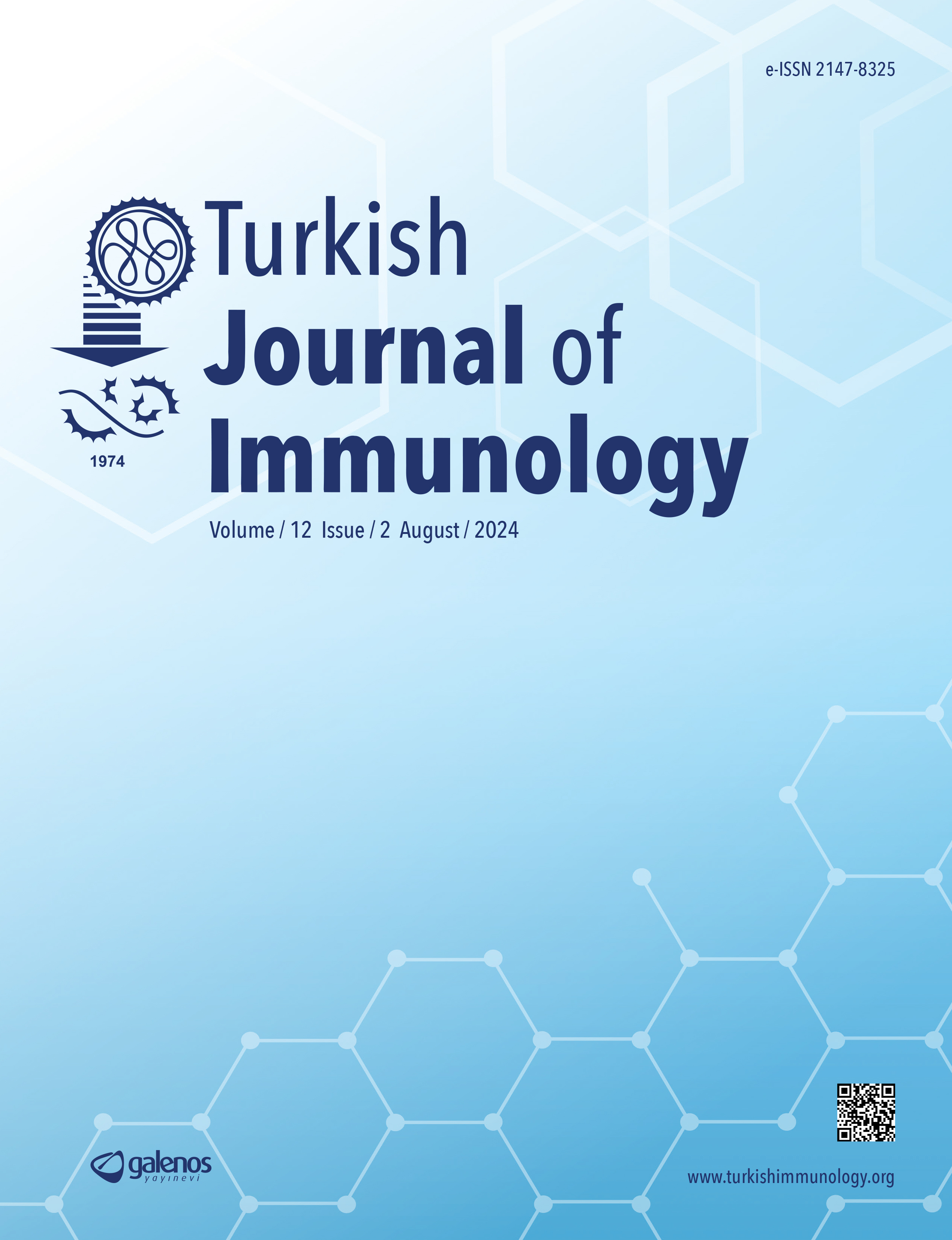Index








Applications



Membership



Volume: 11 Issue: 2 - 2023
| 1. | Cover Page I |
| EDITORIAL | |
| 2. | Editorial Gunnur Deniz Page II |
| REVIEW ARTICLE | |
| 3. | Ayurveda and Allopathic Therapeutic Strategies in Immune Thrombocytopenic Purpura: An Overview Sayali Rajendra Kale, Pallavi Abhijit Patil doi: 10.4274/tji.galenos.2023.81894 Pages 42 - 50 Idiopathic thrombocytopenic purpura (ITP) is characterized by immunologic destruction of platelets and normal/enlarged megakaryocytes in the bone marrow. ITP is broken down into acute and chronic variants. Acute forms cause significant bleeding, whereas chronic forms develop slowly and exhibit minimal to no symptoms. Body makes antibodies that are directed against its own platelets, which can lead to internal bleeding, thrombocytopenic purpura, and petechiae. Immunosuppressants, thrombopoietin receptor agonists, corticosteroids, intravenous immunoglobulins, anti-D immunoglobulin, rituximab, and splenectomy are among the treatments for chronic ITP. Around two thirds of patients benefit from existing treatments; however, some sufferers are resistant to them or do not respond to them over the long term. According to Ayurveda scriptures, ITP is related to Tiryaga Raktapitta because all of the Doshas are vitiated, flowing in the blood and manifesting subcutaneously. |
| ORIGINAL RESEARCH | |
| 4. | Computational Repurposing of Certain Monoclonal Antibodies for the Treatment of Systemic Lupus Erythematosus Haitham Ahmed Al-Madhagi doi: 10.4274/tji.galenos.2023.88700 Pages 51 - 58 Objective: More than 3 million individuals globally suffer from systemic lupus erythematosus (SLE) with no radical therapy for such a multi-organ disease. The present in silico study explores the virtual repurposing of certain monoclonal antibodies (mAb) against the emerging target toll-like receptor 7 (TLR-7). Materials and Methods: The 3D structure of TLR-7 and the shortlisted mAb were retrieved from Alphafold and Thera-SabDab datasets, which were then subjected to docking by pyDockWEB and HDOCK webservers. Molecular dynamics (MD) simulations and MM/GBSA were also predicted for the best docked complex. Results: Bevacizumab was the best potential antagonist mAb of human TLR-7 in terms of protein docking. MD simulations unveiled the stability and the flexibility of the docked complex and MM/GBSA predicted the hotspot residues of the TLR-7-Bevacizumab. Conclusion: Bevacizumab can be deemed as potential repurposed mAb for treating SLE in silico, which needs experimental validation. |
| 5. | Immune Response Profile Induced by Combined Alum and Glycyrrhizin Liposomes in Balb/c Mice Immunized with Ovalbumin Sara Tahvili, Seyyed Meysam Abtahi Froushani, Ramin Yaghobi doi: 10.4274/tji.galenos.2023.76768 Pages 59 - 65 Objective: Saponin compounds, including Glycyrrhizin, can enhance immune responses. The current investigation was conducted to study the effects of alum and Glycyrrhizin Liposomes (GL) as adjuvants on the humoral and cellular responses of the immune system in mice immunized with ovalbumin (OVA). Materials and Methods: Male Balb/c mice were immunized with OVA adjuvant with alum, GL, or alum-GL combination twice at two-week intervals. Two weeks after the last immunization, the specific immune responses against OVA were assessed. Results: The adjuvant formulated with alum and GL induced a Th1 cytokine pattern against OVA, while alum alone induced a Th2 cytokine pattern. The combined adjuvant increased the potential of OVA to induce a delayed- type hypersensitivity reaction and IgG2a antibody titer compared to other groups (p<0.05). OVA-specific lymphocyte proliferation did not show significant differences among the three groups receiving adjuvant (p=0.11). Conclusion: Unlike alum, the combination of alum and GL synergistically increased the cellular and humoral immune responses after immunization with an antigen and therefore had the ability to be used as an adjuvant to induce cellular immune responses. |
| 6. | Evaluation of Polyclonal Antiserum Against Secretory Aspartyl Proteinase of Candida albicans as a Potential Serodiagnostic Tool for Invasive Candidiasis Mohammed Ibrahim Gheit, Tarek Moustafa Mohamed, Marwa Ahmed Abdelwahab doi: 10.4274/tji.galenos.2023.83702 Pages 66 - 73 Objective: Candida albicans (C. albicans) is an important agent of human Candidiasis. It expresses different virulence factors to evade host immunity and facilitate tissue invasion, including secretory aspartyl proteinases (Saps) secretion. For early and quick detection of systemic candidiasis, serological tests can be used instead of traditional blood cultures. This study aims to develop a polyvalent antiserum against (Sap) secreted by C. albicans and test its ability to be used as a diagnostic method in systemic Candida infections. Materials and Methods: Candida was obtained from clinical samples, and its different species were specifically characterized, and followed by C. albicans extracellular protease purification. Antiserum against purified (Sap1) was prepared by immunizing two rabbits with 10 μg of purified (Sap1) protein followed by three booster doses (once/week). Prepared anti (Sap1) antibodies were tested for the detection of (Sap1) in Candida species extracts by western blotting technique in addition to constructing indirect ELISA using prepared anti (Sap1) antiserum. Results: Among the tested species, C. albicans showed the highest extracellular proteases activity (18.6-fold with 2142 U/mg specific activity and 39% recovery). Polyclonal anti (Sap1) antiserum showed maximum ELISA titer and strong reactivity with many pathogenic Candida strains protein bands. Prepared antiserum had a greater binding capacity to pathogenic than non-pathogenic Candida strains and reacted strongly with pathogenic Candida strains even at low dilution. Conclusion: Our findings suggested that the prepared anti (Sap1) antiserum showed high productivity in detecting pathogenic Candida and could be used in serodiagnosis of invasive candidiasis. |
| 7. | Expression of High Mobility Group Box 1 and Receptor for Advanced Glycation End Products in the Gingival Tissues of Periodontitis Patients with Type 2 Diabetes Mellitus Ramya Raj, Devapriya Appukuttan, Sangeetha Subramanian, Prakash PSG, Jasmine Crena doi: 10.4274/tji.galenos.2023.44977 Pages 74 - 92 Objective: Diabetes mellitus (DM) and periodontitis (PD) share similar pathophysiology including altered immune-inflammatory responses, and evidence implicates high mobility group box 1 (HMGB1)-receptor for advanced glycation end products (RAGE) axis in amplifying inflammation. Therefore, we aimed to investigate their expression in gingival tissues from individuals with Stage III/IV PD with and without type 2DM (T2DM). Materials and Methods: Thirty-three gingival tissue samples were taken from Group I: Systemically and periodontally healthy, Group II: Systemically healthy with PD and Group III: PD with T2DM. Tissue and gene expression were evaluated by immunohistochemistry and reverse transcription quantitative-polymerase chain reaction. The staining intensity distribution (SID) and the mean percentage of positive stained cells (MPPC) scores were reported. Results: When compared to group I, the gene expression of HMGB1 and RAGE were 2.85 and 2.50 times higher in PD+T2DM, respectively (p<0.001). MPPC and SID for HMGB1 and RAGE expression were high in Groups II and III, with increased expression in PD+T2DM. Furthermore, when compared to Group I, the expression was significantly higher (p<0.001). In the 33 samples, MPPC and SID scores for HMGB1 and RAGE in the epithelium and connective tissue significantly correlated with clinical parameters (p<0.001). With a diagnostic accuracy of 87.88% [95% confidence interval (CI): 72.67-95.18] and a positive and negative predictive value of 95% and 76.92%, respectively, HMGB1 was able to distinguish between periodontal health and disease. RAGE had a diagnostic accuracy of 93.94% (95% CI: 80.39-98.32) with a positive and negative predictive values of 91.67% and 100%, respectively. Conclusion: Increased HMGB1 and RAGE expression underscores their significance in amplifying inflammation in PD associated with T2DM. Furthermore, both can be used as diagnostic biomarkers. |




